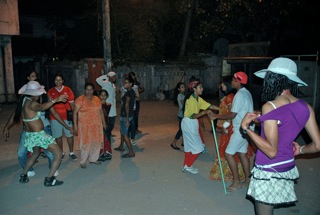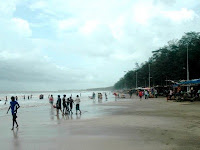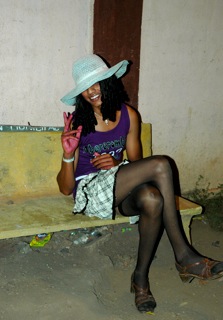Carnival 2011
The Carnival – spelt, ‘Carnaval,’ in Portuguese – is a Portuguese legacy which is making a big comeback with the Catholics of Daman. It had reached its height in the 80’s and is seeing a revival since the past 3-4 years with Carnival 2011 taking it a notch higher than last year’s celebrations.
This annual three-day festival is celebrated in Brazil, Goa and other former Portuguese colonies. It begins on the first Sunday of Lent though there’s no connection with Lent from a religious angle.
 |
| This is the main road in Big Daman – people are coming out of Machiwar (one of the ‘Bairros’ of Daman) and heading towards the football field |
Unlike the Goa carnival which is termed as the ‘commercialized’ version, the Daman Carnival is unique in that it’s not a sponsored event and is truly the carnival ‘of the people, by the people – and most importantly – for the people!’ In fact, the Catholics who take part in the three-day event, don’t even approach any commercial establishment for sponsorship.
The first day of carnival is called, ‘Domingo Gordo‘ (‘Fat’ Sunday:) in Portuguese. The Damanense ‘espatada‘ (pigling BBQ) accompanied with the local liquor and a special salad made from brinjals (eggplant) baked underground and Portuguese music is the de rigueur staple!
 |
| Revelers dancing in one of the ‘Bairros’ of Big Daman |
Portuguese music, especially Pimba, is a favourite as it makes it easy to use the beat for marching along the streets, incorporating the same dance-steps used in the Damanense wedding march!
Daman Day 2011 Celebrations
Daman Day 2011 was celebrated on “Dia de Damao” – 2nd of February which also coincides with the feast of “Nossa Senhora das Candeias” – an annual, open air mass held on the forecourt of the DMC building and offered by the councillors and staff of the Daman municipal council.
Due to the ongoing DMC elections, the organizers of “Daman Day 2011” decided not to have the sports and cultural events this year and instead hire out a restaurant-cum-discotheque for celebrating their 4th Daman Day soon after the mass. A special bus ferried revelers to venue – “Nana’s,” in Small Daman at 8pm and dropped them back at 11pm.
The theme for Daman Day 2011 was…
Mr. Gabriel Guedes, well-known orator of Daman, made the welcome speech in Portuguese which was followed by a toast raised with the traditional goblets of port (albeit Goan) wine! This was followed by the quintessential Portuguese traditional dance – the Vira – performed by children in authentic costumes to the musical performances of the Daman Folklore Group.
The evening flew by in the time it took to sample the starters and down a couple of drinks, with renditions of popular Damanense folk songs as revelers jammed with the folklore group.
Then there was the customary session of ballroom dancing to peppy Portuguese music by DJ Rambo before dinner was served. The traditional Daman “Dampaque” took centre stage on the buffet table as did a bottle of the local fiery drink, “Benslor” on the bar counter!
Soon it was time to sip liqueur and head for the bus but not before everyone made a pact to meet again on Carnival 2011!
Visit http://www.WorldDamanDay.com for more!
Sao Joao

Sao Joao (St. John’s feast) was celebrated yesterday, 24th June 09, in Damao (Daman) Portuguese style as usual with ‘add-ons.’
I woke up around 7am to firecrackers in the churchyard as well as echoes from the various ‘bairos.’
The day was spent putting up effigies made by stuffing old suits with straw and firecrackers. An earthen toddy pot is used for the head which is also stuffed with straw and firecrackers. The effigies are usually of men.
I had a rather heavy lunch around noon – the traditional ‘vale nascido,’ a dish made of sprouted beans garnished with salted cubes of pork fat.
After lunch, I packed my family into our car and headed for the beach. Damanenses don’t wear conventional swimwear. Men and boys wear Bermuda shorts and women and girls opt for slacks and Tees. Typically, Damanenses seldom protect their eyes with sunglasses. Very few actually swim, preferring to frolic in the waves near the shoreline.
We waded along the shoreline from Ferrieros to Badrapor but got back into the car and drove to Jampore beach around 4pm. Jampore was where the party was in full swing – Damanenses from Small Daman preferred crossing the creek over to Big Daman than partying on rocky, Devka beach. There were people in the water and in little groups on the shore under the needle pine trees, partying – eating, drinking canned beer, strolling, snapping pictures, cruising in cars.
There was more fun in store elsewhere later in the evening – the ‘Judas’ effigies were burnt all over town.
For those that missed all the fun or would like a replay on a smaller scale, there’s always Sao Pedro (St. Peter’s feast) to look forward to on the 29th of June.
The first rain of the season
Daman had its first showers on Sunday afternoon, lasting over two hours.
When it stopped, the sun did come out again, to give Daman that clean-washed look and to release an earthy-scented vapor all evening.
Jampore beach in Big Daman was jam-packed with tourists and so was Devka beach in Small Daman.
San Joao (St. John’s feast) is on Wednesday, the 24th of June – looking forward to photographing the glut of ‘Val nacido’ (sprouted beans) in the bazaar – it looks as if there’s nothing else on display but ‘Val nacido!’ It’s the same scene on Good Friday – but it’s ‘Bred’ (green leafy veg) used for the devil’s recipe, ‘Aag sal de bred’ to tempt those fasting to pig out at lunch.
And ‘Val nacido’ is no newborn’s food either – you need a shard of ‘Papri’ (papad) as the only piece of cutlery, to scoop out a portion of the beans and garnishing of salted cubes of pork fat, and convey it into your mouth – you eat the ‘papri too – each time!’
The next logical step is a swill of liqour. Some spoilsports swig beer. A few rounds of this and then you’re ready for your first clumsy plump into a surf-n-sand roller.
Right – eat/drink, rinse and repeat! As easy as that!
By my calculations, high tide is around 5pm on San Joao and 9pm on San Pedro (29th June).
Oh, despite the 360 degree pollution (dirt, water/air pollution and corruption) in Daman, life is good in a secret place called, Damao.









